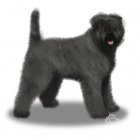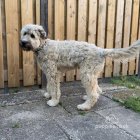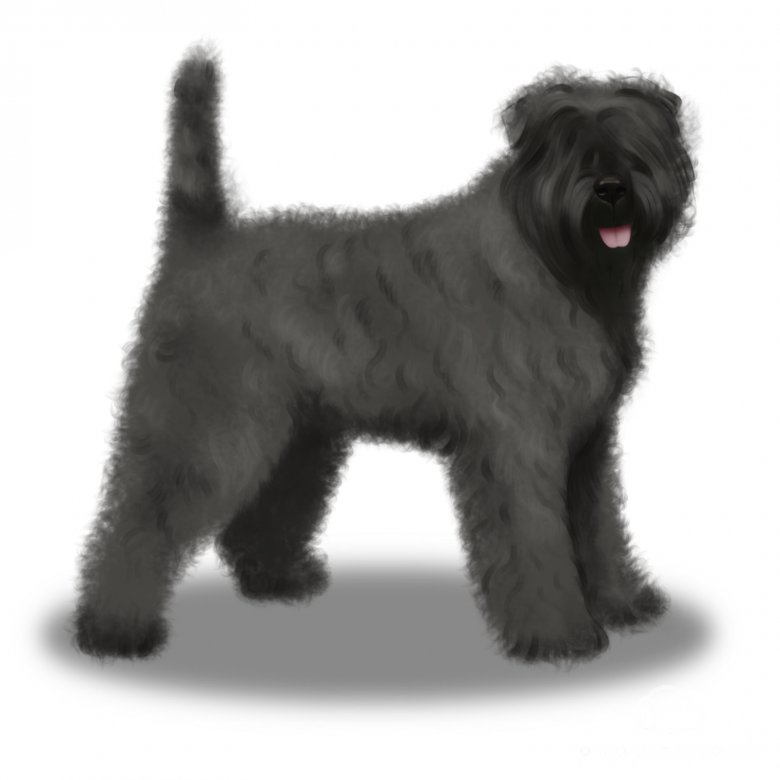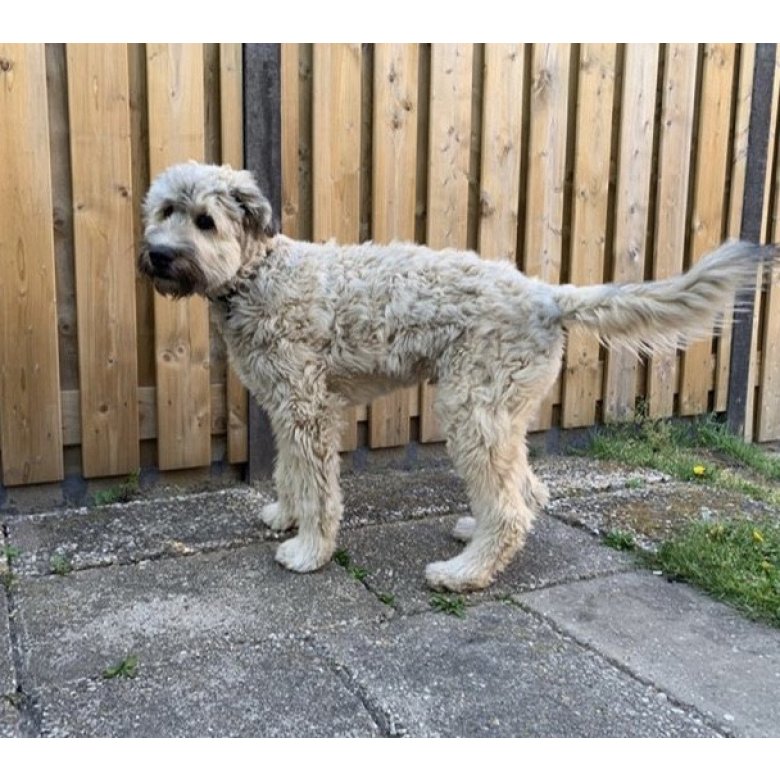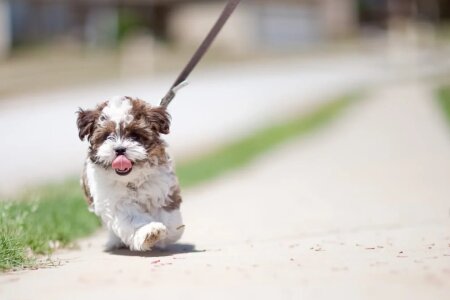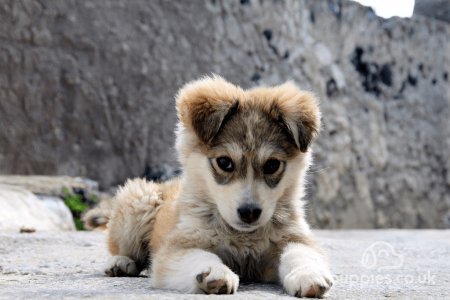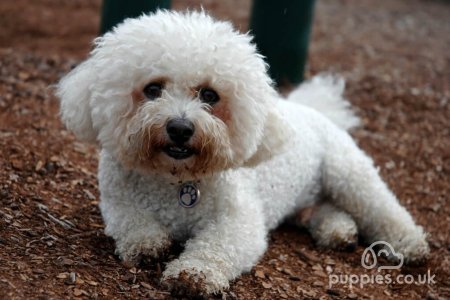Few dog breeds boast the kind and gentle temperament with the power and beauty of the Bouvier des Flandres. This large cattle herding breed from Flanders is a superb puppy choice for anyone looking to own a rare breed that makes for a loving companion with a rich and often sad history of near-extinction. Late United States President Ronald Reagan owned a Bouvier named Lucky, and that’s the sentiment that many owners feel when they own a Bouvier puppy. Not only are they rare in the UK but they’re also a less popular breed than most, perhaps because their excellent qualities have yet to be widely noticed in the UK. This is all the more reason to take one of these loving companions home.
Why Bouviers des Flandres are Great
Some highlights of Bouviers des Flandres:
Family-friendly: Bouviers have a warm and affectionate temperament around owners and their families.
Strength: this breed is famed for its robust strength and is able to pull carts and perform work duties if required.
Watchdog: this breed is an excellent choice for those looking for a reliable watchdog.
Intelligence: Bouviers are highly intelligent and can be trained fairly easily.
Barking: for a breed of its size, the Bouvier hardly barks at all and can keep quiet when properly trained.
Things to Consider when Looking at Bouviers des Flandres for Sale
Some downsides to the Bouvier des Flandres:
Messy: since they have large, bushy moustaches, eyebrows, and beards, Bouviers can be messy eaters.
Odour: some breeds tend to have a unique smell, but the Bouvier can have an unpleasant odour due to its tendency towards flatulence as well as due to food and dirt accumulating in his hair.
Isolation: most breeds don’t like to be left alone, but the Bouvier will get bored more quickly than most other breeds and can engage in naughty behaviour.
Shedding: some Bouviers don’t seem to shed much at all, but most actually do shed substantial amounts of hair which can become caught and tangled in their outer coat.
History of the Bouvier des Flandres
The Bouvier’s ancestry dates back to at least as far back as the 19th century in Belgium and Northern France. General all-purpose working farm dogs were widely used in this region for herding cattle, sheep, churning milk, pulling carts, and much more. Whether by design or by accident, breeding of sheepdogs in the region of Flanders began to produce variations of the Bouvier’s ancestors. The three known breeds were the Paret, Moerman/Roeselare, and the Briard. Unfortunately, due to conflict of opinion by each variant’s breeders, the Bouvier was not recognised as a formal breed until much later in the 20th century. During the First World War, Bouviers were widely used as trench dogs. Their excellent strength, agility, and intelligence made them prized messenger dogs, stretcher-bearers, and hauling and carting dogs. This led to a large decrease in their population, nearing extinction by the end of the war. Although breeding programmes began again after the war, the Second World War once again called these loyal canines to front line duty. They were used as police dogs and assisted the Dutch Resistance, for example, which saw many die in the line of duty but also their reputation as loyal police dogs became widespread.
Appearance
Bouviers can be recognised by their powerful, rugged posture that exudes strength and size whilst having excellent agility and stamina. This breed was bred as a working farm dog, so its strong physique can be clearly seen.
This breed has a thick double coat of fur that is prone to matting. Profuse hair growth is common on the head, giving the Bouvier its signature beard, moustache, and thick eyebrows that cover most of the face area. Some may find this feature to be intimidating, especially when the hair covers so much of the face that only the nose can be seen.
How big is the Bouvier des Flandres?
Bouviers des Flandres are large-sized dogs. Males grow on average to 58–71 cm in height, whilst females can grow up to 56–69 cm high.
How heavy is a Bouvier des Flandres?
Fully-grown adult male Bouviers des Flandres weigh between 36-54 kg on average. Females Bouviers weigh between 27-36 kg on average.
What colour is the Bouvier des Flandres?
This breed has the following commonly-accepted coat colours:
Some white is permissible on the chest, but light colours and predominant white are undesirable.
Temperament
Bouviers des Flandres have a kind and gentle temperament. Despite their intimidating looks, they are big-hearted, loyal companions that make excellent companions for owners and families with children. They are also quite intelligent and capable of performing many tasks, owing to their working farm dog origins. Some heavy-duty tasks such as cart hauling are not a problem for this powerful breed. As puppies, Bouviers will need to be well-trained and socialised in order to curb naughty behaviour. They may nip and chew when excited or bored and may also exert dominance over other pets if they haven’t been properly introduced. This means that, on the one hand, Bouviers are great for first-time owners willing to put in the effort, but on the other hand should be avoided if their owners cannot tolerate their temperament and embrace them fully from puppyhood to adulthood.
Do Bouviers des Flandres make good guard dogs?
Bouviers are excellent watchdogs and are naturally inclined to keep watch. They are not the best guard dogs, however, since they prefer to keep their distance from strangers.
Do Bouviers des Flandres bark a lot?
This breed doesn’t bark often at all. He will bark to alert his owner of suspicious activity, but compulsive barking isn’t a problem.
Are Bouviers des Flandres easy to train?
If raised as puppies, Bouviers can be easy to train due to their high intelligence and ability to become obedient and loyal to their owners. They can, however, exhibit signs of stubbornness or bad behaviour if their owner lacks a sense of authority to teach them their role and what they can and cannot do.
Are Bouviers des Flandres playful?
As puppies, Bouviers are a playful breed indeed. They can get a little too excited at times and should be taught authority as puppies. As adults, they are far less playful but they’re still a joy to be around.
Are Bouviers des Flandres good with children?
Bouviers are an excellent puppy choice for families with children. Due to their large size and their boisterous playfulness as puppies, they should be supervised when playing with toddlers.
Are Bouviers des Flandres good with other pets?
This breed has a prey drive for small pets and a tendency to exert dominance over other dogs. Cats and smaller pets may be chased around and possibly hurt. If socialised and taught to respect his role, he can learn to get along with other dogs.
Can I leave a Bouvier des Flandres alone?
Bouviers are able to tolerate being left alone for extended periods of time, but that doesn’t mean they should be neglected either. They tend to become bored easily, and bored dogs are likely to engage in destructive behaviour.
Do Bouviers des Flandres like water?
In general, Bouviers enjoy the water and are good swimmers. Their thick double coats can get hot in the summer, so they may be more likely to jump in during these warmer months. As with all puppies, allow them to interact with water on their own and with supervision so that they don’t become frightened of the water.
Health
How long do Bouviers des Flandres live?
Generally, Bouviers des Flandres are expected to live anywhere from 5-10 years, with 8 years being considered average.
How much exercise does a Bouvier des Flandres need?
Although Bouviers are a large breed, they aren’t too energetic and require less exercise than many other breeds. An hour a day should be spent taking them outdoors for a walk or to play off the lead, but don’t overdo it as puppies since their bones are still developing.
What are a Bouvier des Flandres’s common health issues?
In the UK, Bouviers are generally seen as being a healthy breed. In Europe where they are more popular, they have shown some hereditary health issues, including:
Care
How much space do I need for a Bouvier des Flandres?
Plenty of space is required for a Bouvier des Flandres. This breed is large and thus unsuitable for urban apartment dwelling. Large homes with gardens are ideal.
What should I feed my Bouvier des Flandres?
A fully-grown Bouvier des Flandres should be fed 3 to 5 cups of high-quality dog food every day. Adjust feeding to the age, activity level, and to prevent overfeeding. Note that Bouviers are known to be messy eaters due to their profuse facial hair and they’re also prone to flatulence.
How much grooming do Bouviers des Flandres need?
Bouviers require frequent grooming, brushing, and cleaning. Their dense double coats and bushy beards and moustaches attract a lot of dead hair, food, and bacteria if they aren’t cleaned every day.
Do Bouviers des Flandres shed?
Although Bouviers aren’t known for shedding, dead hair can sit between their two coats and they should therefore be brushed every day to keep their coats beautiful and clean.
Average Costs
How much does it cost to keep a Bouvier des Flandres?
As a rough guide in pricing: Cost to buy: roughly £500-800 for a well-bred Bouvier des Flandres puppy Other costs (Vet, Food etc): £100-130 per month
Specific Buying Guide
You can read our general buying guide here, with the most important thing being going to view your Bouvier des Flandres puppy, seeing it with its mother, and checking the quality of the breeder. More specifically, here is some Bouvier des Flandres puppy buying advice:
Bouviers are naturally wary of strangers. As puppies, they may not warm up to you at first, and that’s all right. Excessive shyness is not a desirable trait, however, so look for signs of shyness with caution.
As a breed that faced extinction and has not gained widespread popularity in the UK as in Europe, Bouviers may be difficult to acquire. Be prepared to search for a while before taking one home and always endeavour to ensure that the puppy was bred according to Kennel Club standards in ethical conditions.
Other Reading, Adopting Bouvier des Flandres Puppies and Rescue Organisations
A big thank you to the following sources who helped to shape this article: Bouvier des Flandres Club of Great Britain: https://bouvierclub.co.uk/rescue-welfare/ Bouvier Welfare: https://www.bouvierwelfare.co.uk/ Kennel Club of Great Britain: https://www.thekennelclub.org.uk/services/public/breed/display.aspx?id=5115 UK Dog Trust: https://www.dogstrust.org.uk/ Blue Cross: https://www.bluecross.org.uk/rehome-pet Federation Cynologique Internationale: https://www.fci.be/Nomenclature/Standards/191g01-en.pdf






